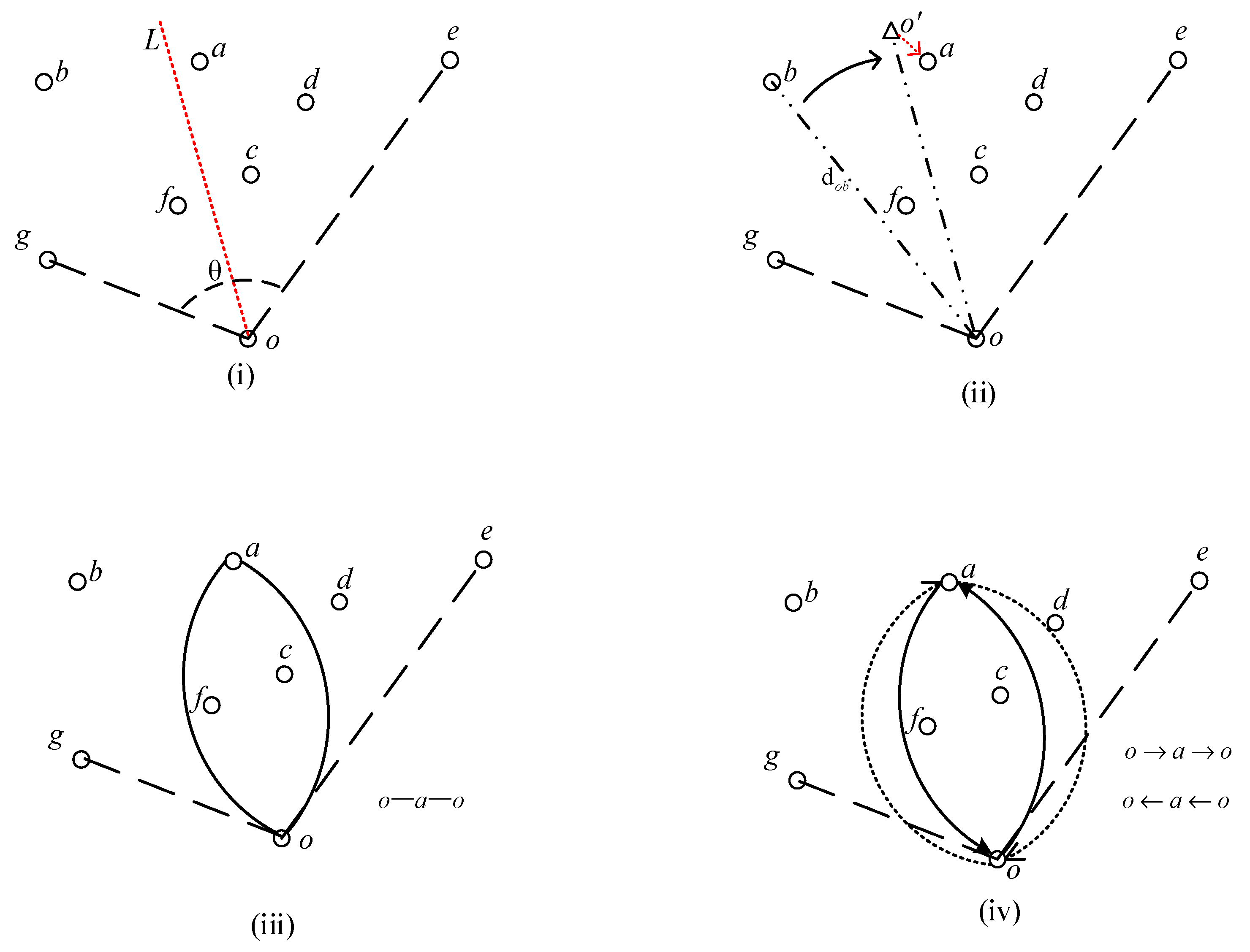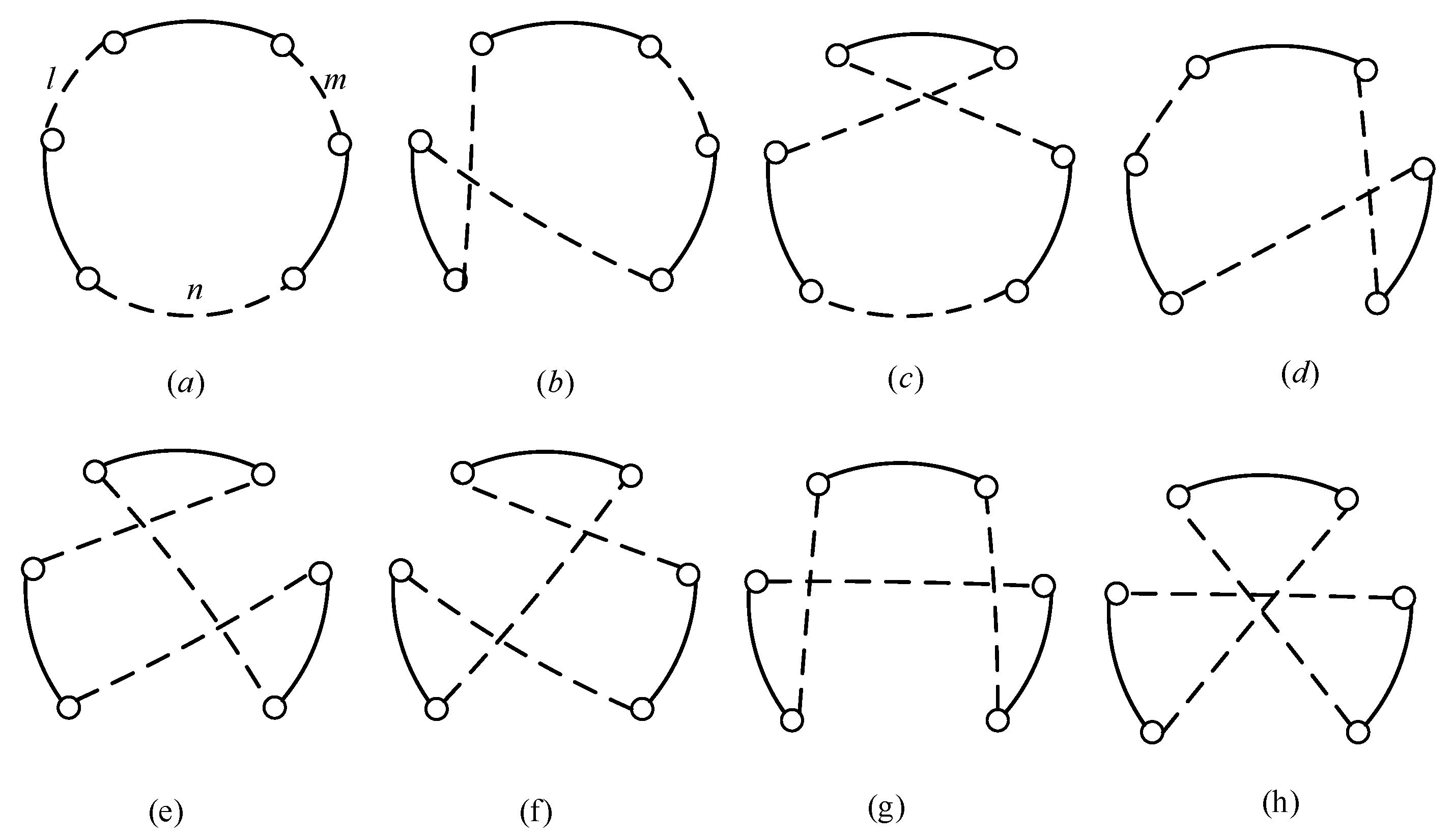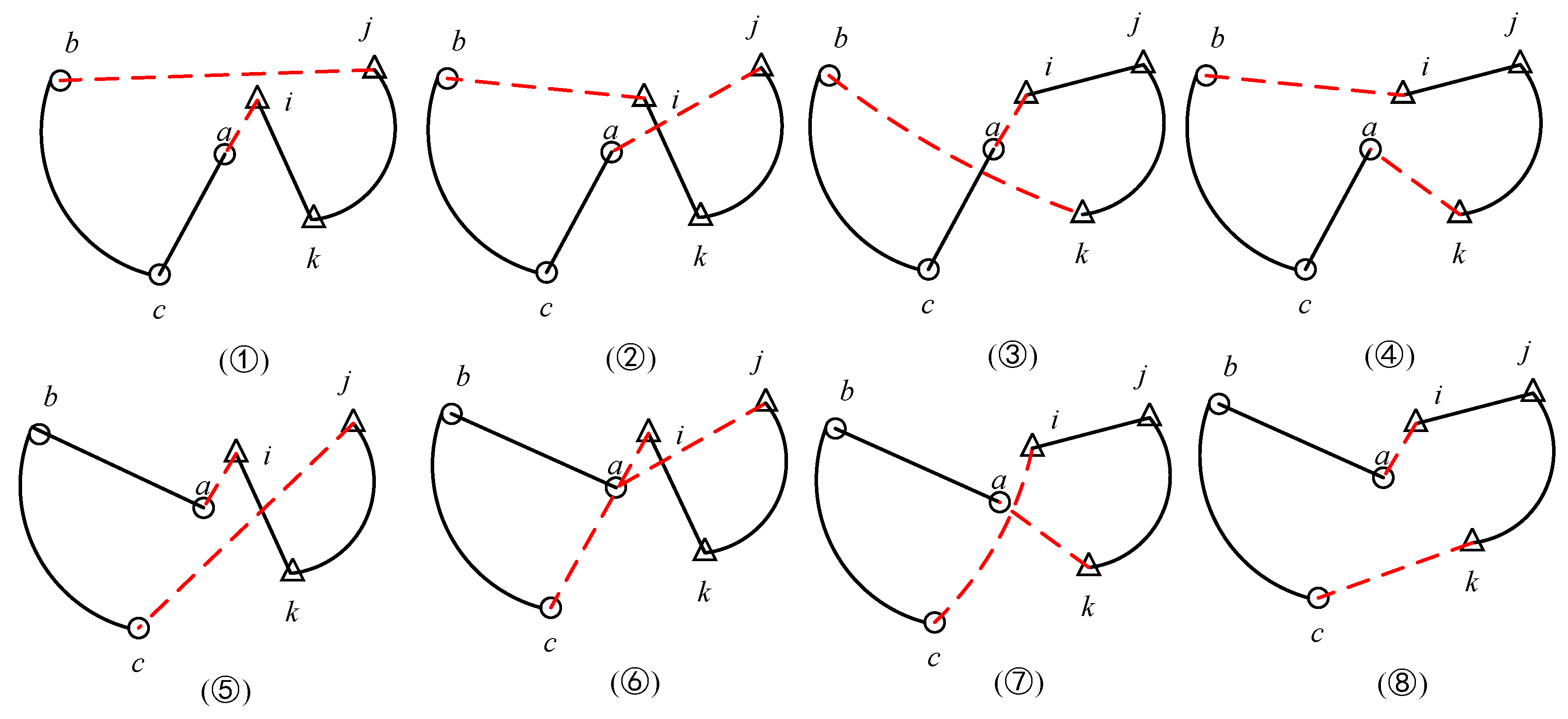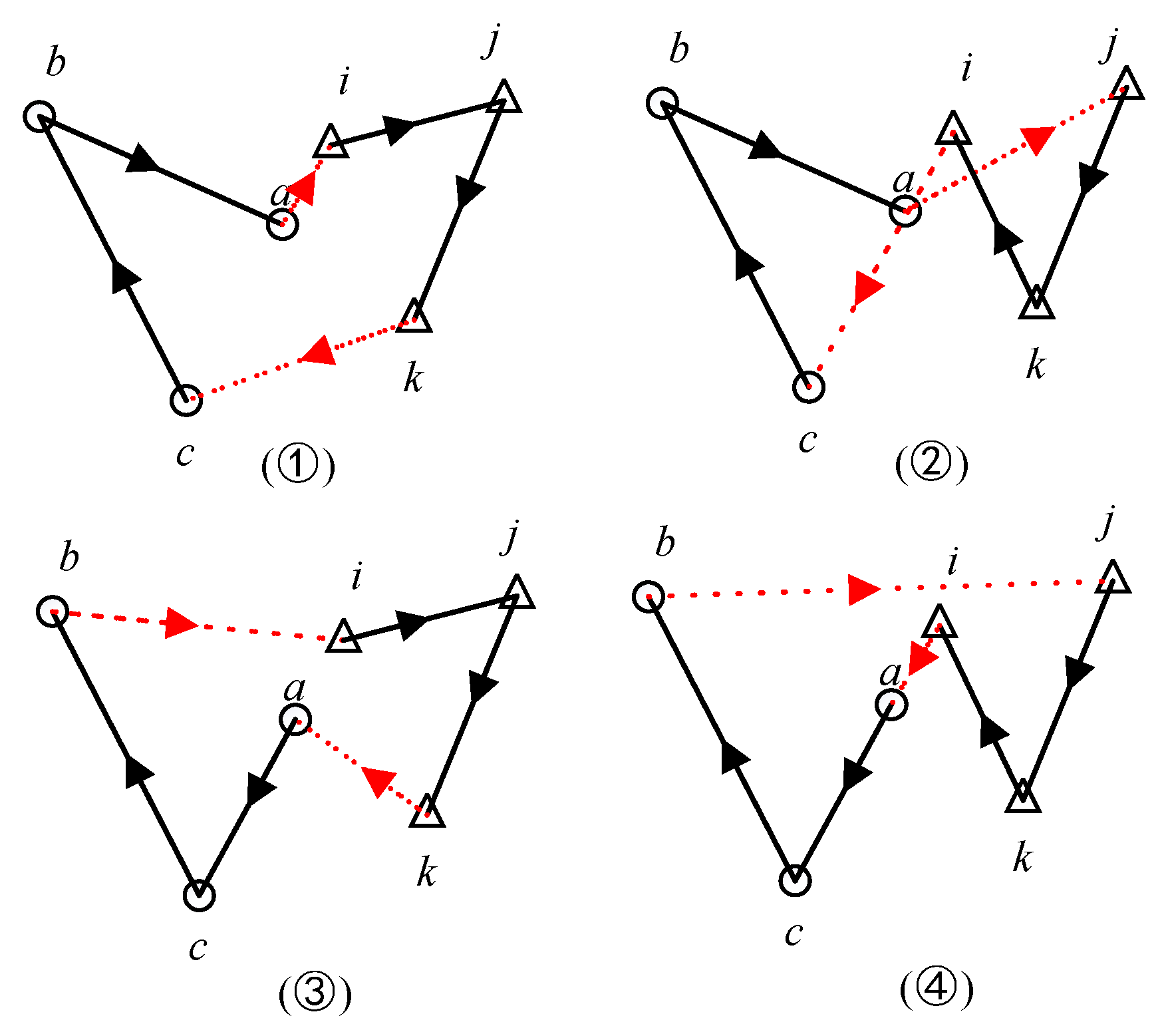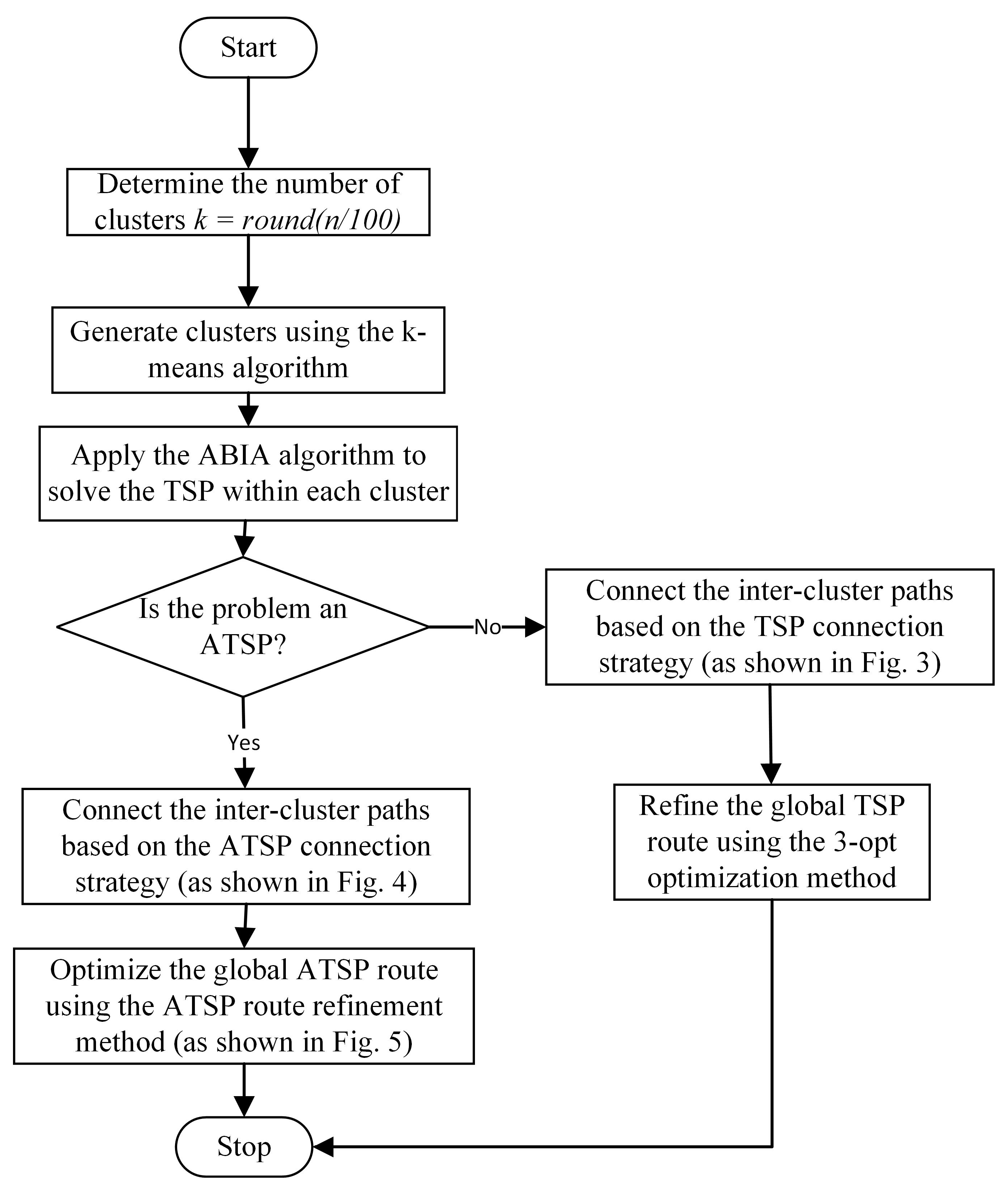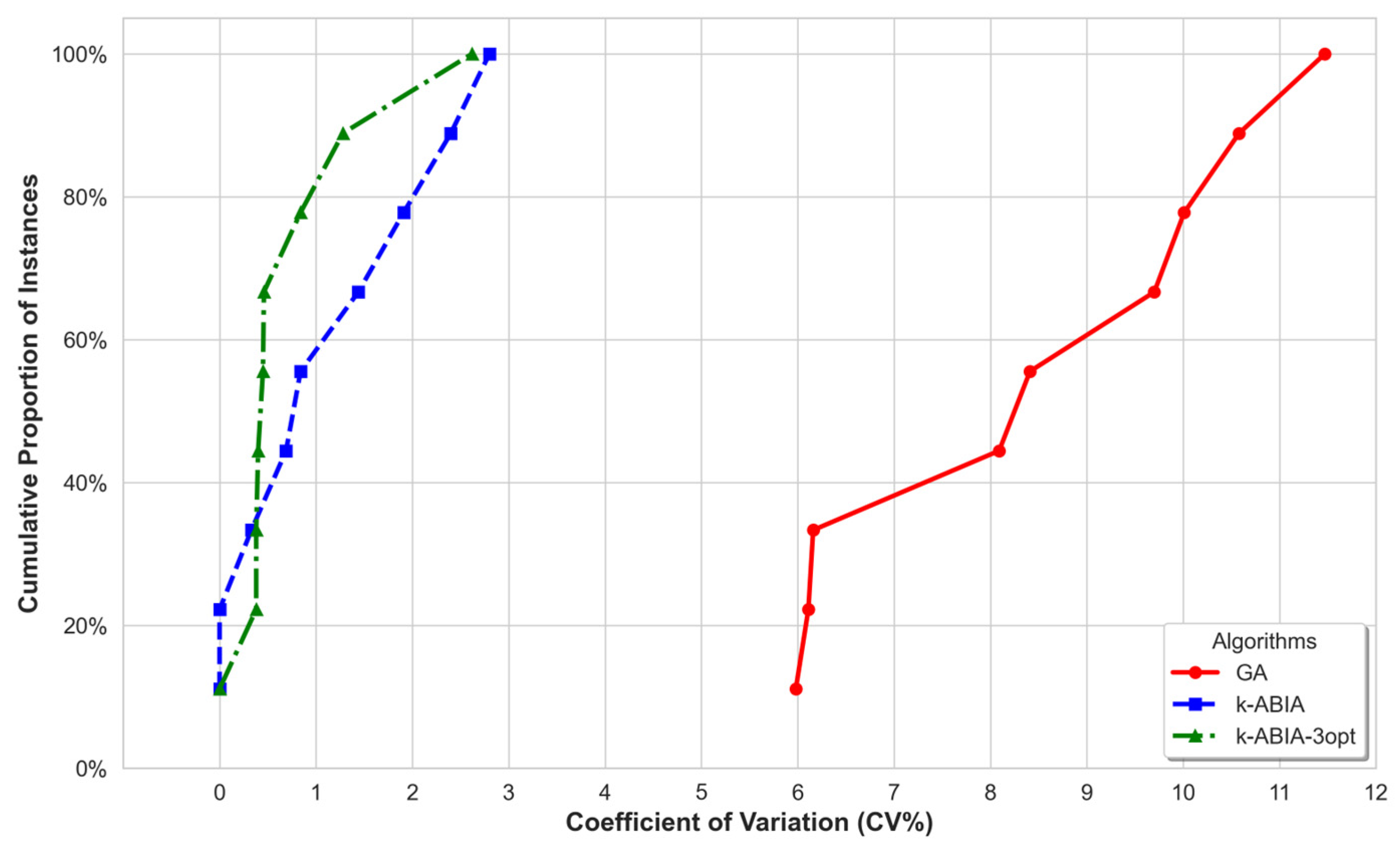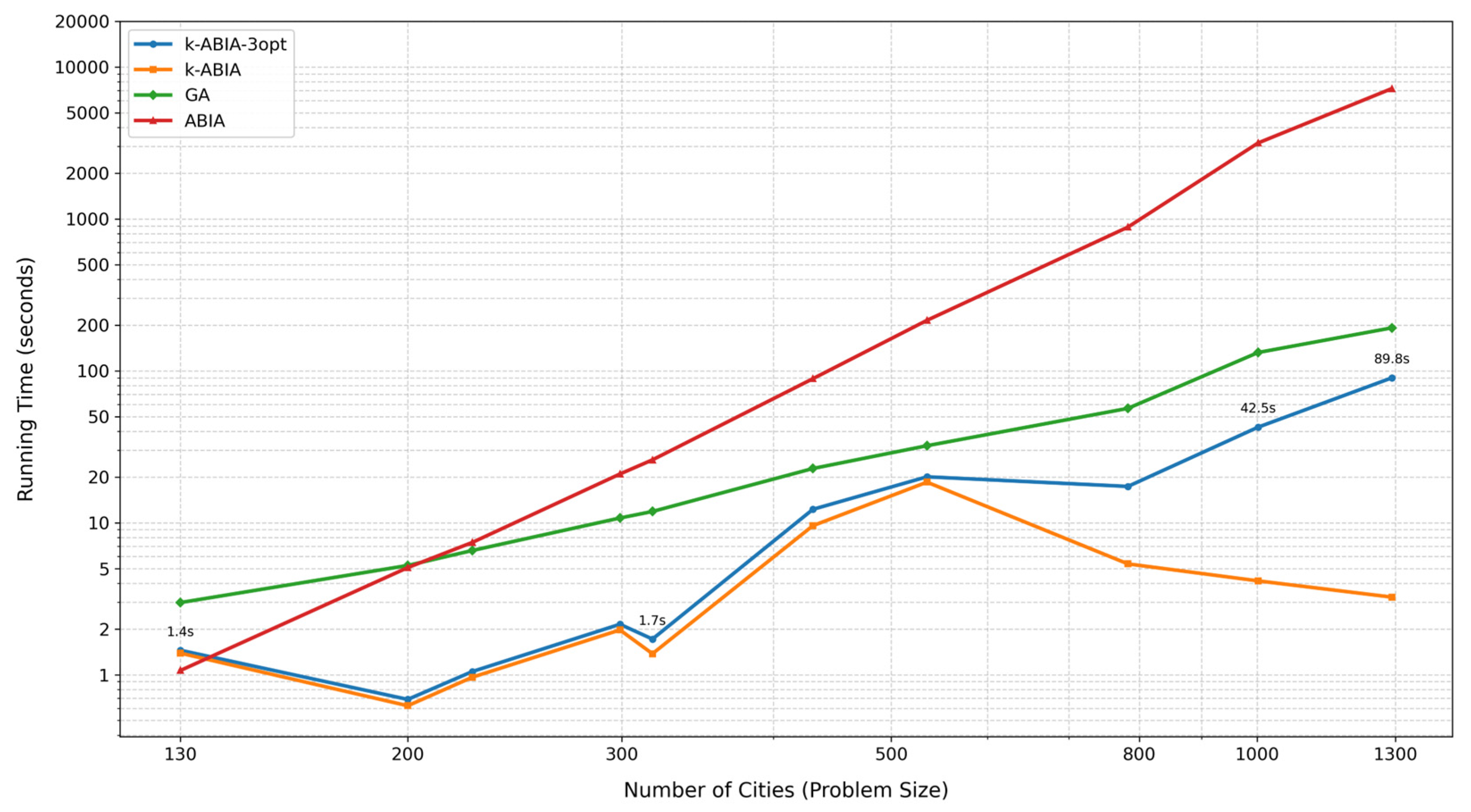1. Introduction
The symmetric Traveling Salesman Problem (TSP) is a classical NP-hard combinatorial optimization problem that seeks a closed tour with the minimum total distance, given a set of cities and the pairwise distances among them. Mathematically, it is equivalent to finding the minimum Hamiltonian circuit in a weighted complete graph. The history of the problem can be traced back to Euler’s study of the knight’s tour in the 18th century, while its modern formal definition was clearly presented by Karl Menger in the 1930s. The problem gained significant attention in the 1950s when Dantzig and Johnson successfully solved a 49-city instance using cutting plane methods [
1,
2]. In 1972, Richard M. Karp proved that the Hamiltonian circuit problem is NP-complete, indirectly establishing the NP-completeness of the TSP and providing a theoretical basis for its computational complexity [
1]. As the number of cities increases, the search space grows exponentially. For example, the number of possible tours for 30 cities reaches the order of 1032, with the possibilities for symmetric and asymmetric TSP being n!/2 and n!, respectively [
3]. The asymmetric TSP (ATSP) refers to the case when a weighted complete graph is converted into a weighted complete directed graph, where the cost of arc (
i,
j) is not equal to that of (
j,
i). This asymmetry prevents ATSP from being simplified to the TSP and necessitates an explicit treatment of directional constraints [
4]. The TSP also serves as a mathematical foundation for a wide range of real-world applications, including circuit board drilling, logistics routing, warehouse robotics, and various combinatorial optimization problems involving cost minimization.
Current methods for solving the TSP fall into two categories: exact algorithms and heuristic algorithms. Exact algorithms, which guarantee finding the optimal solution, include methods such as branch-and-bound, the Dantzig–Fulkerson–Johnson (DFJ) integer programming model, and dynamic programming. The core idea of the branch-and-bound method is to recursively partition the search space (branching) and eliminate non-promising subsets (bounding) to gradually approach the optimal solution [
5]. The DFJ integer programming model ensures that the TSP forms a single tour by adding appropriate constraints, although the number of these constraints grows on the order of
[
6]. The Held–Karp algorithm, a dynamic programming approach, has a time complexity of
, rendering it practical only for up to 30 cities due to substantial memory requirements [
7]. While exact algorithms guarantee optimality, they become prohibitively difficult to solve for large-scale instances owing to the enormous computational resources required [
8,
9]. Consequently, exact algorithms are generally suited to small-scale problems or applications requiring very high accuracy—such as last-mile drone delivery [
10] and path planning in integrated circuit lithography.
When exact algorithms encounter computational bottlenecks, heuristic algorithms can quickly obtain approximate solutions by mining problem-specific features and applying intelligent search strategies. Heuristic methods can be further divided into metaheuristic algorithms, deep learning-based solvers, and constructive heuristics. Metaheuristics, which remain a hot research topic, simulate natural phenomena or collective intelligence to perform guided random searches in the solution space. Notable examples include the Migrating Birds Optimization (MBO) algorithm, which mimics the cooperative mechanisms of migrating birds (e.g., formation flying and information sharing) [
11]; Genetic Algorithms that simulate natural selection, crossover, and mutation processes [
12]; the relatively novel Grey Wolf Optimization, inspired by the social behaviors of gray wolves [
13]; and the Discrete Artificial Bee Colony (DABC) algorithm, which models the foraging behavior of bees and integrates domain-specific operators for optimization [
14]. Among swarm intelligence methods, the Ant Colony Optimization algorithm is particularly popular, simulating the pheromone-based foraging behavior of ants to find better paths [
15]. Particle swarm optimization, inspired by the synchronized speed adjustments observed in bird flocks, achieves rapid convergence in continuous spaces [
16]. A more recent development is the Discrete Tree Seed Algorithm (DTSA), which mimics the natural process of tree propagation—including seed generation, dispersal, and survival of the fittest—to accommodate the characteristics of permutation-based optimization problems [
17]. In recent years, parallel optimization strategies have been widely adopted in swarm intelligence algorithms. For example, the Parallel Binary Cat Swarm Optimization (PBCSO) algorithm divides the population into multiple subgroups that evolve independently and periodically exchange information through communication mechanisms to enhance global search capabilities [
18]. In addition, the Discrete Symbiotic Organisms Search (DSOS) algorithm, which fuses gene transfer and path crossover elimination strategies, facilitates information exchange among multiple groups of symbiotic organisms and effectively mitigates the tendency of traditional discrete symbiotic algorithms to get trapped in local optima and exhibit insufficient convergence when solving the TSP [
19].
With the rise in deep learning in recent years, end-to-end training methods can directly learn path construction rules from TSP instances, thereby overcoming the reliance on the domain knowledge characteristic of traditional algorithms. For example, a method based on the Transformer architecture uses reinforcement learning for training without relying on pre-existing TSP solutions [
20]. Another study developed a deep learning framework that employs deep convolutional networks to extract features from TSP instances, integrating data augmentation techniques to handle complex cases [
21]. Moreover, Q-learning has been applied to optimize TSP formulations in multi-robot formation tasks [
22]. In addition, deep learning models can be combined with heuristic algorithms—such as hybrid genetic algorithms and multi-agent reinforcement learning algorithms—to solve the TSP [
23]. By merging metaheuristics and deep learning, researchers primarily target medium-to-large TSP instances, achieving faster solution speeds with smaller deviations. These methods find broad applications, including optimizing meal-preparation sequences for restaurant chefs [
24], handling large-scale pharmaceutical and fresh produce deliveries [
25], implementing the Multi-Traveling Salesman Problem (M-TSP) for multi-vehicle cooperative distribution [
26], and planning municipal garbage truck routes in conjunction with genetic algorithms to reduce travel distance [
27].
However, certain scenarios impose strict requirements on both response time and solution stability, making traditional metaheuristics or deep learning approaches less directly applicable. Examples include the following:
Food delivery systems require real-time route updates (within 1 s per new order) under dynamic order influx. Traditional metaheuristics suffer from prolonged iteration times (minute-level) and potential solution instability during dynamic adjustments.
Earthquake rescue drones necessitate rapid coverage path planning in communication-constrained environments.
Network base station repairs demand immediate multi-site maintenance route generation to prevent service disruptions.
Robotic formation tasks require both rapid response and high stability for coordinated maneuvers.
In such contexts, constructive heuristic algorithms demonstrate distinct advantages due to their inherent properties:
- (1)
Single-pass solution construction: Feasible solutions are generated directly via deterministic or semi-deterministic rules, bypassing iterative optimization and enabling millisecond-level computation.
- (2)
Rule-driven stability: Deterministic construction rules ensure consistent outputs, mitigating solution volatility.
- (3)
Domain knowledge integration: Heuristic rules explicitly embed domain-specific constraints (e.g., traffic regulations, physical limitations) with minimal parameter tuning and straightforward implementation.
Prominent constructive heuristics include the nearest-neighbor method [
28], farthest insertion [
29], convex hull algorithm [
30], and the recently proposed Angular Bisector Insertion Algorithm (ABIA) [
31].
The Angular Bisector Insertion Algorithm (ABIA) leverages the spatial distribution characteristics of point sets to construct angular bisectors that partition the set into left and right subsets. It then incrementally inserts the points from these subsets into a tour according to predefined insertion rules. As a constructive heuristic algorithm based on geometric principles, ABIA demonstrates strong performance in small-scale Traveling Salesman Problems (TSPs), characterized by solution stability, high computational efficiency (at the millisecond level), and high solution quality. However, when applied to large-scale or high-complexity asymmetric TSPs (ATSPs), ABIA suffers from limitations such as reduced solution quality and increased computational complexity. The core challenge lies in effectively reducing the overall problem complexity. To address this, a “Divide-Connect-Optimize” three-level collaborative strategy has emerged as a key approach to enhancing ABIA’s performance. This divide–solve–connect framework was first proposed by Croes (1958) and has since become a classical model supporting both symmetric and asymmetric TSPs in automated solution processes [
32]. Recent studies have increasingly focused on integrating clustering-based pre-segmentation techniques—aimed at reducing subproblem sizes—with metaheuristic optimization methods that improve solution quality. One notable example is the hybrid strategy combining k-means clustering and the Ant Colony Optimization algorithm [
33].
In this work, the k-means clustering algorithm [
34] is employed to partition the point set, with each resulting small-scale TSP subproblem solved using the ABIA. Subsequently, inter-cluster connection rules are constructed to link multiple TSP tours. To accommodate the structural differences between TSP and ATSP, distinct inter-cluster connection strategies are designed accordingly. After the inter-cluster tour is formed, a post-processing phase is applied, incorporating the 3-opt algorithm [
35] along with a set of custom-designed path refinement rules, to mitigate the risk of convergence to local optima.
This framework yields two improved variants of ABIA: one that integrates k-means clustering and 3-opt optimization (termed k-ABIA-3opt), which focuses on enhancing solution quality; and another that omits the 3-opt refinement step (termed k-ABIA) to emphasize computational efficiency. Both variants are applicable to TSP instances of varying scales and application requirements. Given node coordinates and the pairwise distances (or weights) between nodes, the algorithm can generate a directed or undirected tour that minimizes the total travel cost or distance. Beyond solving TSP and ATSP, the core design philosophy underlying the proposed methods—namely, complexity reduction through clustering and solution refinement via local heuristics—may hold potential for broader applications such as feature selection in high-dimensional data analysis [
36]. For instance, in problems like sparse linear discriminant analysis for image classification, where selecting representative subsets from large feature spaces is essential, similar clustering and path construction strategies could be adapted to identify optimal feature combinations. While the current study remains focused on combinatorial routing problems, this direction suggests promising avenues for future cross-domain extensions.
The structure of this paper is organized as follows:
Section 2 introduces the related research, including the Angular Bisector Insertion Algorithm, k-means clustering, and 3-opt optimization.
Section 3 details the proposed improved Angular Bisector Insertion Algorithm that fuses k-means and 3-opt.
Section 4 provide an analysis of the characteristics and time complexity of the improved algorithm.
Section 5 presents comparative experiments using TSPLIB standard datasets, contrasting the performance of the proposed algorithm with the traditional ABIA and a genetic algorithm.
Section 6 concludes the study and discusses future research directions.
3. Algorithm Proposal
To address the issue of poor solution quality when solving large-scale TSPs using the ABIA, this paper introduces the k-means algorithm to divide the large TSP into multiple smaller TSP subproblems. For each smaller TSP, the ABIA’s strengths—such as excellent solution quality for small-scale problems, high stability, and fast computation speed—are leveraged for solving. Additionally, inter-cluster connection rules are established to effectively link the paths between multiple clusters. Furthermore, due to the insertion characteristics of the ABIA, which may lead to local optima, this paper further incorporates the 3-opt algorithm for optimization, thus improving solution quality and global search capability. Based on this, an improved Angle Bisector Insertion Algorithm, integrating k-means and 3-opt, is proposed to further enhance the TSP solving performance. The algorithm steps are as follows:
Divide the point set into k clusters:
Since the ABIA demonstrates superior solution quality and computation speed for up to 100 points, the number of clusters is set to appropriately partition the problem size.
- 2.
For each cluster
, apply the ABIA to solve the TSP path (parallel processing can be employed to improve efficiency):
- 3.
To connect all clusters, a nearest-point connection search strategy between clusters is defined to identify the optimal connection scheme between cluster Ci and cluster Cj.
Within clusters
Ci and
Cj, the closest pair of points is identified:
Suppose the closest pair of points is
, where
a is a point in cluster
,
is
a point in cluster
j,
b and
c are the adjacent points before and after
a, and
j and
k are the adjacent points before and after
. Based on different edge disconnection strategies, the following eight connection methods are designed (other points in the loop are omitted), as shown in
Figure 3:
①②③④⑤⑥⑦⑧; there are eight connection methods in total. The distance variations are computed, and the scheme with the shortest total distance is selected to optimize the overall inter-cluster connection. This strategy ensures that the inter-cluster connections are efficient and adhere to the optimal path principle, thereby improving the global solution quality.
In the ATSP, since the loops generated by the ABIA are directional, the designed connection scheme must consider directionality constraints. Cluster
can disconnect either the
ac or
ba edge and can also disconnect either the
ij or
ki edge. By disconnecting one edge from each pair, a connection method is determined. Therefore, there are a total of four connection methods, as shown in
Figure 4: ①
②
③
④
.
- 4.
After merging the clusters to form a complete loop, direct connections between multiple clusters are prone to getting stuck in local optima, affecting the final path quality. Therefore, the 3-opt algorithm is introduced to optimize the path, thereby improving the overall solution quality. However, the traditional 3-opt algorithm is primarily suited for the TSP and needs to be appropriately adjusted for the ATSP to fit the problem characteristics.
Inspired by the 3-opt optimization approach, the complete TSP loop is divided into four continuous path segments using three splitting points (in conjunction with the starting point), as shown in
Figure 5. Here, let
o be the starting point of the loop, and
i,
j, and
k represent the three key splitting points. The loop can then be divided into the following four path segments.
seq1: The path from the starting point o to i;
seq2: The path from i + 1 to j;
seq3: The path from j + 1 to k;
seq4: The path from k + 1 to the endpoint z.
During the optimization process, to ensure the consistency of the loop’s direction, only the exchange of different path segments is allowed, without changing the direction of node visits. Based on this, three path exchange methods are designed to optimize the overall path length:
- (a)
Exchange seq1 with seq2, adjusting the path structure between the starting point and the first partition point.
- (b)
Exchange seq2 with seq3, optimizing the path connection in the middle segment.
- (c)
Exchange seq3 with seq4, adjusting the connection method of the terminal path.
After each exchange, the length of the optimized path is calculated. If the new path length is shorter than the original path, the exchange operation is accepted, continuously iterating to optimize the overall loop structure. This improvement strategy further enhances the final solution quality, resulting in better paths after cluster merging, leading to the final solution.
In summary, the improved Angular Bisector Insertion Algorithm (ABIA), which integrates K-means clustering and 3-opt optimization, consists of four main steps, as detailed in the pseudocode in Algorithm 1 and illustrated by the flowchart in
Figure 6. It is worth noting that Step 4 (Path Optimization) is an optional step; omitting it can significantly reduce the computational time, especially for large-scale problem instances.
| Algorithm 1 Improved Angular Bisector Algorithm Combining K-means and 3-opt (TSP Point Set V, Distance Matrix D) |
| 1 | Step 1: Clustering Division |
| 2 | Clusters ← KMeans(V, k) //, n represents the number of point groups. |
| 3 | Step 2: Calculate the optimal path within the cluster. |
| 4 | for each Cluster in Clusters do |
| 5 | LocalRoute[Cluster] ← ABIA(Cluster, D) // Optimize the intra-cluster path using the ABIA. |
| 6 | end for |
| 7 | Step 3: Connect the inter-cluster path. |
| 8 | if ProblemType == TSP then |
| 9 | GlobalRoute ← ConnectClusters_TSP(LocalRoute, D) // The 8 connection methods used (Figure 3). |
| 10 | else if ProblemType == ATSP then |
| 11 | GlobalRoute ← ConnectClusters_ATSP(LocalRoute, D) // The 4 connection methods used (Figure 4). |
| 12 | end if |
| 13 | Step 4: Path optimization. |
| 14 | if ProblemType == TSP then |
| 15 | GlobalRoute ← 3OptOptimization(GlobalRoute, D) // Path optimization using 3-opt (Figure 2). |
| 16 | else if ProblemType == ATSP then |
| 17 | GlobalRoute ← PathExchangeOptimization(GlobalRoute, D) //Path exchange optimization (Figure 5). |
| 18 | end if |
| 19 | Return GlobalRoute |
5. Experimental Analysis
This section compares the performance of the proposed improved Angular Bisector Algorithm combining K-means and 3-opt (k-ABIA-3opt), as well as its simplified version without 3-opt refinement (k-ABIA), against several benchmark algorithms. The comparison includes the classical Genetic Algorithm (GA), the original ABIA, and a competitive discrete metaheuristic—Adaptive Ant Colony Optimization (AACO-LST) [
39].
These algorithms are selected to represent a wide range of solution strategies for the Traveling Salesman Problem (TSP). The Genetic Algorithm is a well-established evolutionary approach; the original ABIA serves as a baseline for evaluating the effects of clustering and path refinement; and AACO-LST represents a class of discrete algorithms tailored for combinatorial optimization problems such as TSP. AACO-LST has demonstrated strong performance in producing high-quality solutions in various studies, making it a valuable point of comparison in this context.
All methods are tested on standard benchmark instances from TSPLIB [
40], a widely used repository of TSP datasets with varying sizes and structural properties, ensuring a comprehensive evaluation of solution quality and computational efficiency.
The experiments were carried out in an environment with 16 GB of RAM and an Intel i5-12500H CPU, with the algorithms implemented in Java 21. To minimize the effects of randomness, each algorithm was run 50 times, and the average results were taken.
Best Solution Deviation (BSD) was employed to evaluate the solution accuracy with respect to the known optimal values. The deviation is computed using the following expression:
This metric quantifies the relative distance between the obtained solution and the best-known solution, allowing for consistent performance comparison.
The subsequent experimental analysis is structured into four parts:
Evaluation of solution quality.
Assessment of algorithmic stability.
Analysis of computational efficiency.
Performance evaluation of asymmetric TSP instances.
5.1. Evaluation of Solution Quality
In this section, 17 benchmark instances containing 50 to 1000 nodes are selected, consistent with those used in the AACO-LST algorithm study [
39]. The results of AACO-LST are directly adopted from the original publication for consistency and fair comparison. For the Genetic Algorithm (GA), the parameter settings are based on those reported in the paper [
31], which have been shown to ensure convergence, as detailed in
Table 1. In contrast, k-ABIA-3opt, ABIA, and k-ABIA do not require any parameter tuning. These algorithms operate without the need for manual adjustment, contributing to their robustness and ease of use in practice.
Table 2 presents a comparative summary of the best solutions obtained by each algorithm across the benchmark instances. Based on these results, a rank-based evaluation was performed, in which algorithms were ranked for each instance according to their best solution quality, measured by the shortest tour length. In cases where two or more algorithms achieved the same best value, a tie was recorded and the same rank was assigned.
Table 3 reports the frequency distribution of ranks obtained by each algorithm over all 17 instances, along with their corresponding average rank.
Furthermore, the average rank data from
Table 3 were used to generate the histogram (
Figure 7), while the BSD (Best Solution Deviation) values listed in
Table 2 were used to construct the cumulative deviation plot (
Figure 8). Together,
Figure 7 and
Figure 8, along with the tabulated results in
Table 3 and
Table 4, form the foundation for the following key observations:
Across the 17 medium-to-large-scale TSP instances ranging from 51 to 1084 cities, the k-ABIA-3opt not only achieved the top average rank but also produced the best solutions in 7 instances—both metrics highlighting its superior solution quality compared to the other evaluated algorithms.
The cumulative deviation of the k-ABIA-3opt was 66.95% lower than that of the k-ABIA, clearly demonstrating the effectiveness of local search strategies applied after clustering. Additionally, the cumulative deviation of k-ABIA was 49.23% lower than that of the original ABIA, confirming that the clustering–connection strategy significantly improves solution quality.
5.2. Assessment of Algorithmic Stability
In this subsection, TSP instances ranging from 100 to 1000 cities were randomly selected for evaluation. Both k-ABIA and k-ABIA-3opt include a single source of randomness—namely, the initial centroid selection in K-means clustering. These two algorithms were compared against GA, a representative metaheuristic method. ABIA, being a fully deterministic rule-based algorithm, was excluded from this comparison. For each instance, the best, average, and worst solutions were recorded, along with the standard deviation (Std) and coefficient of variation (CV), defined as follows:
where
N denotes the total number of solutions,
is the average (Avg), and
is the
solution.
Table 4 reports the stability comparison among algorithms.
Figure 9 shows the cumulative distribution of CV values. From
Table 4 and
Figure 9, the following observations can be made:
In all tested instances, the average and worst solution values obtained using k-ABIA-3opt were consistently better than those of the comparative algorithms, reflecting its advantage in both solution quality and stability.
In
Figure 7, the k-ABIA-3opt curve is concentrated near the left (low CV), with 80% of its CV values below 1%. Both k-ABIA-3opt and k-ABIA kept CV values under 3% across all instances, reflecting strong stability.
5.3. Analysis of Computational Efficiency
In this subsection, ten TSP instances ranging from 100 to 1300 cities were selected for evaluating the computational efficiency of the algorithms. Since the AACO-LST paper did not report runtime, only k-ABIA-3opt, k-ABIA, GA, and ABIA were compared. The results are shown in
Table 5, and the runtime trend with increasing problem size is illustrated in
Figure 10. The key findings are summarized as follows:
k-ABIA achieved the shortest runtime across all instances, with a maximum of only 18 s. In comparison, the total runtime of k-ABIA was approximately one-fourth of k-ABIA-3opt, one-tenth of GA, and just 1⁄61 of ABIA.
A noticeable runtime spike was observed for ABIA on the gr431 instance. This is due to unbalanced k-means clustering in that instance, where one cluster contained over 200 cities, resulting in an expensive individual ABIA execution.
Based on the algorithmic characteristics, the theoretical time complexity of ABIA is
, while GA has a complexity of
[
31], where
is the initial population size and
T is the number of iterations. ABIA’s runtime exceeded GA’s when the number of cities surpassed 210, consistent with its higher computational complexity. Although k-ABIA-3opt also has a theoretical complexity of
, its actual runtime was significantly reduced due to the clustering-and-partitioning strategy, which effectively narrows the 3-opt search space. k-ABlA does not utilize the 3-opt optimization path, so its time complexity is
. Since k-ABlA has much smaller constant factors compared to GA, its running speed is faster.
5.4. Performance Evaluation of Asymmetric TSP Instances
In this subsection, since both k-ABIA-3opt and k-ABIA incorporate inter-cluster connection and path optimization rules specifically designed for ATSPs, we evaluated their solution quality on all ATSP instances with more than 100 cities from the TSPLIB benchmark. The AACO-LST algorithm was not designed for ATSPs and therefore was excluded from comparison. The comparison was carried out among k-ABIA-3opt, k-ABIA, GA, and ABIA. As established in
Section 4, both k-ABIA-3opt and k-ABIA exhibit lower time complexity in ATSP than in TSP, and their runtime stability remains consistent with that observed in
Section 5.2; hence, only solution quality is evaluated in this subsection.
Table 6 reports the best solution deviations (BSDs) and rankings across ATSP instances, while
Table 7 summarizes the overall performance. From these results, we observe the following:
k-ABIA-3opt achieved the highest average rank across all ATSP instances, followed by ABIA, k-ABIA, and GA. Its total BSD was only 24%, approximately one-twelfth that of GA. This superior performance stems from the fact that k-ABIA-3opt, k-ABIA, and ABIA all incorporate ATSP-specific design strategies. The lower solution quality of k-ABIA relative to ABIA indicates that clustering, by itself, fails to enhance solution quality in ATSP tasks. This further underscores the effectiveness of integrating a dedicated local search mechanism, as employed in k-ABIA-3opt, in enhancing solution quality.
6. Conclusions
To address the issues of poor solution quality and high time complexity in ABIA for medium- to large-scale TSPs, this study proposes two improvement strategies: k-ABIA (which integrates k-means clustering with ABIA) and k-ABIA-3opt (which further incorporates 3-opt optimization). These strategies employ a “Divide-Conquer-Construct-Optimize” three-phase collaborative mechanism, balancing both efficiency and precision.
k-ABIA employs K-means to partition large-scale problems into subproblems, reducing the time complexity of ABIA from to . It then leverages the advantages of ABIA for smaller-scale TSPs while avoiding the high cost of global search. For symmetric TSP instances, eight inter-cluster connection strategies were specifically designed to link the clusters formed by k-means, followed by 3-opt-based route optimization. For asymmetric TSPs (ATSPs), four directed connection strategies were developed for the clustered subproblems, with corresponding refinement procedures applied after connection to further enhance solution quality.
Experimental results show that in large-scale TSP instances (with 100–1000 cities), k-ABIA-3opt generally outperforms k-ABIA, GA, AACO-LST, and ABIA in terms of solution quality. Regarding stability, both k-ABIA-3opt and k-ABIA demonstrated superior robustness, due to their limited randomness (only in the selection of cluster centroids), compared to GA. In terms of runtime, k-ABIA was the fastest, followed by k-ABIA-3opt, GA, and ABIA. For ATSP instances, k-ABIA-3opt achieved the highest solution quality, surpassing k-ABIA, GA, and ABIA. These results suggest that k-ABIA-3opt is more suitable for time-constrained scenarios where high-quality solutions are required, while k-ABIA offers a more efficient alternative for fast approximate solutions in large-scale settings. Moreover, both k-ABIA and k-ABIA-3opt are effective extensions under large-scale ATSP conditions.
Future research could focus on the following directions:
Dynamic Clustering Strategy: Adaptively adjusting cluster sizes based on path directional characteristics or point group density to improve the feasibility of inter-cluster connections in ATSP.
Initial Point and Bisecting Strategy Optimization: ABIA’s solution quality is significantly influenced by the initial starting point and bisecting direction. Heuristic rules could be designed to precisely select initial points and optimize bisecting directions, reducing time complexity to .
The proposed method holds promise for extension to other combinatorial optimization problems, such as the Vehicle Routing Problem, Quadratic Assignment Problem, and Job Shop Scheduling Problem, by appropriately adapting its clustering and refinement strategies. Furthermore, due to its structure-preserving and subset selection capabilities, the method also shows potential for application in feature selection tasks. These directions will be explored in future research.
